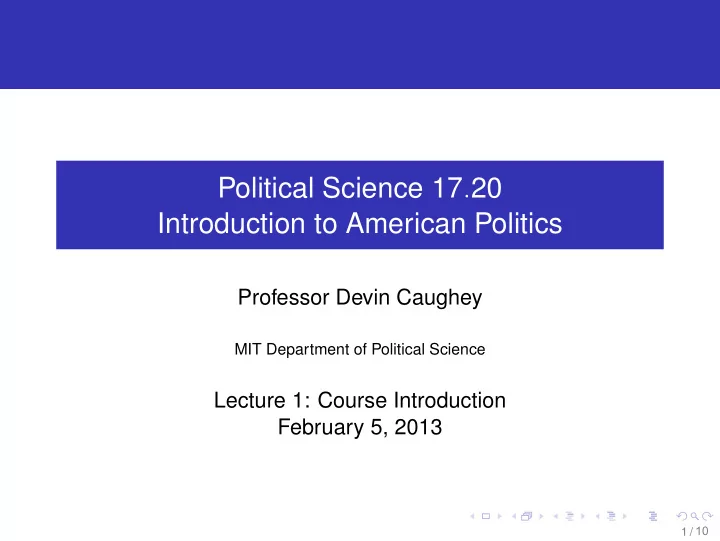

Political Science 17 . 20 Introduction to American Politics Professor Devin Caughey MIT Department of Political Science Lecture 1: Course Introduction February 5, 2013 1 / 10
Today’s Agenda Introductions 1 Overview of course and syllabus 2 Reading quiz 3 Recitation times 4 Writing self-assessment 5 2 / 10
Introductions Professor: Devin Caughey (pronounced “ko-ee”) Research interests: US political development, Southern politics, Congress, public opinion, statistical methods 3 / 10
Learning Goals By the end of this course, students will be able to: Describe the essential features of American politics and government. Understand key conceptual and analytic frameworks of political science. Apply these theoretical frameworks to specific aspects of American politics. Communicate their analyses to others via oral and written compositions appropriate to political science. 4 / 10
Expectations Treat each other with courtesy and respect. Put away laptops and other electronic devices. Act with academic integrity. 5 / 10
Assessment This is a communication-intensive course, so reading and writing will be particularly emphasized. Grades are based on five components: 1 Daily reading quizzes (15%) 2 Oral presentation (10%) 3 Long paper (15% draft, 20% final) 4 Three short papers (10% each) 5 Recitation participation (10%) 6 / 10
Reading and Writing Readings: Books to purchase: Principles and Practice of American Politics , 4th edition Dahl, How Democratic Is the American Constitution? Mayhew, Partisan Balance Articles, mostly scholarly Writing: 3 short papers to prepare for final paper (revision required) Must meet with writing advisor at least once (do it early) 7 / 10
Overview of Semester Part I: Foundations (analytical, cultural, and constitutional) Part II: Institutions (federalism, branches of government, etc.) Part III: Mass Behavior (how ordinary citizens think about and participate in politics) Part IV: American Politics as a System (how it all fits together) Part V: Substantive Debates (five areas of American politics where political science intersects with normative debates) 8 / 10
Key Dates February 26: Short paper #1 March 19: Short paper #2 April 9: Short paper #3 April 18: Tentative idea for long paper topic April 30: Draft of long paper May 16: Revised and final version of long paper 9 / 10
Next Class Readings (to be quizzed!): Gaventa, Power and Powerlessness → Make sure you understand each “dimension” of power Olson, The Logic of Collective Action (Kernell & Smith) Hardin, “The Tragedy of the Commons” (Kernell & Smith) Ostrom et al., “Revisiting the Commons” (PDF) → Olson, Hardin, and Ostrom are all concerned with collective action problems and how to solve them. Putnam, “The Prosperous Community” (Kernell & Smith) Pierson, “Increasing Returns” (PDF) → How institutions persist, develop, and shape behavior; note connections with other readings; work through carefully. 10 / 10
MIT OpenCourseWare http://ocw.mit.edu 17.20 Introduction to American Politics Spring 2013 For information about citing these materials or our Terms of Use, visit: http://ocw.mit.edu/terms .
Recommend
More recommend